We may not know exactly where Philae is, but it’s doing a bang-up job sending its first photos from comet 67P/Churyumov-Gerasimenko. After bouncing three times on the surface, the lander is tilted vertically with one foot in open space in a “handstand” position. When viewing the photographs, it’s good to keep that in mind.
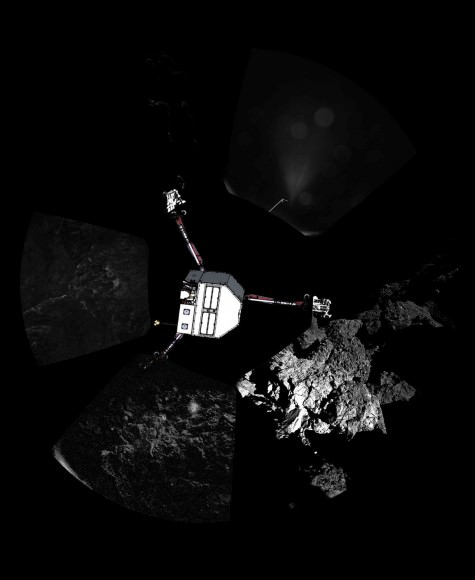
Although it’s difficult to say how far away the features are in the image. In an update today at a press briefing, Jean Pierre Biebring, principal investigator of CIVA/ROLIS (lander cameras), said that the features shown in the frame at lower left are about 1-meter or 3 feet away. Philae settled into its final landing spot after a harrowing first bounce that sent it flying as high as a kilometer above the comet’s surface.
After hovering for two hours, it landed a second time only to bounce back up again a short distance – this time 3 cm or about 1.5 inches. Seven minutes later it made its third and final landing. Incredibly, the little craft still functions after trampolining for hours!
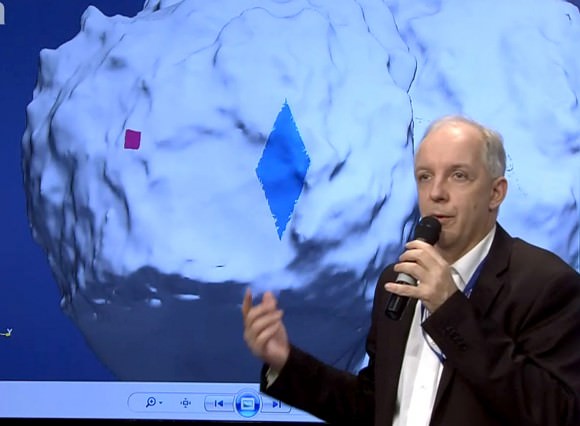
Despite its awkward stance, Philae continues to do a surprising amount of good science. Scientists are still hoping to come up with a solution to better orientate the lander. Their time is probably limited. The craft landed in the shadow of a cliff, blocking sunlight to the solar panels used to charge its battery. Philae receives only 1.5 hours instead of the planned 6-7 hours of sunlight each day. That makes tomorrow a critical day. Our own Tim Reyes of Universe Today had this to say about Philae’s power requirements:
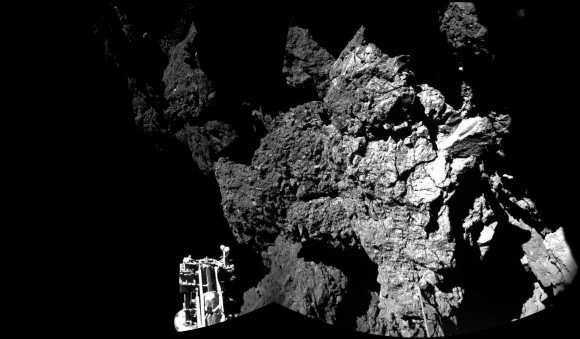
“Philae must function on a small amount of stored energy upon arrival: 1000 watt-hours (equivalent of a 100 watt bulb running for 10 hours). Once that power is drained, it will produce a maximum of 8 watts of electricity from solar panels to be stored in a 130 watt-hour battery.” You can read more about Philae’s functions in Tim’s recent article.
Ever inventive, the lander team is going to try and nudge Philae into the sunlight by operating the moving instrument called MUPUS tonight. The operation is a delicate one, since too much movement could send the probe flying off the surface once again.
Here are additional photos from the press conference showing individual segments of the panorama and other aspects of Philae’s next-to-impossible landing. As you study the crags and boulders, consider how ancient this landscape is. 67P originated in the Kuiper Belt, a large reservoir of small icy bodies located just beyond Neptune, more than 4.5 billion years ago. Either through a collision with another comet or asteroid, or through gravitational interaction with other planets, it was ejected from the Belt and fell inward toward the Sun.
Astronomers have analyzed its orbit and discovered that up until 1840, the future comet 67P never came closer than 4 times Earth’s distance from the Sun, ensuring that its ices remained as pristine as the day they formed. After that date, the comet passed near Jupiter and its orbit changed to bring it within the inner Solar System. We’re seeing a relic, a piece of dirty ice rich with history. Even a Rosetta stone of its own we can use to interpret the molecular script revealing the origin and evolution of comets.
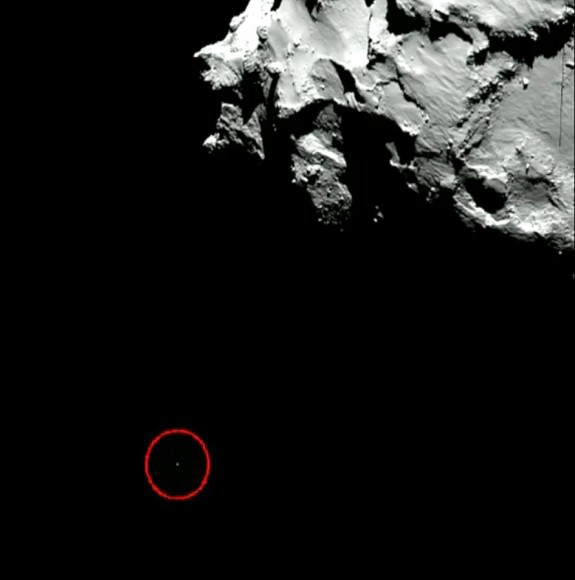
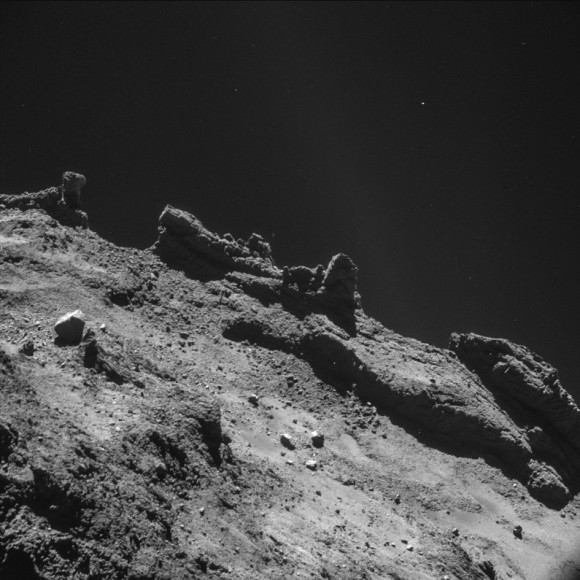
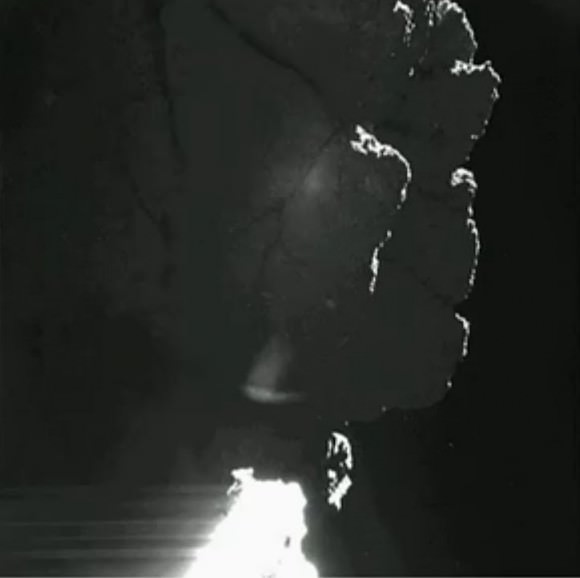
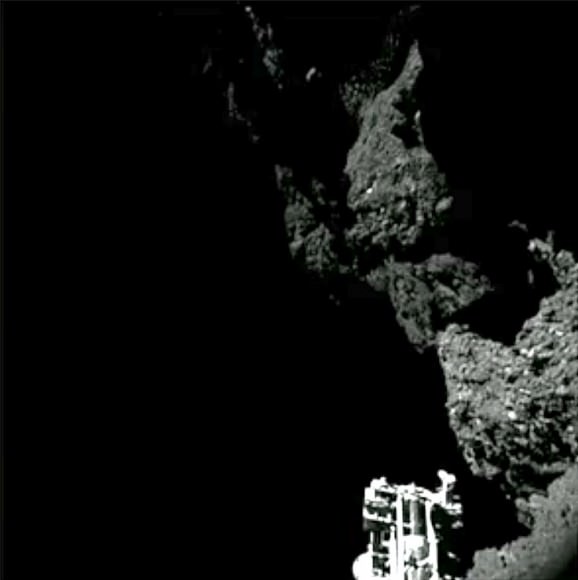
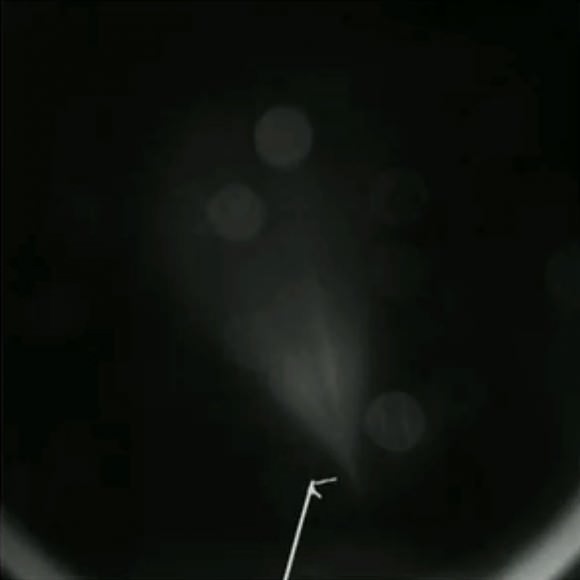
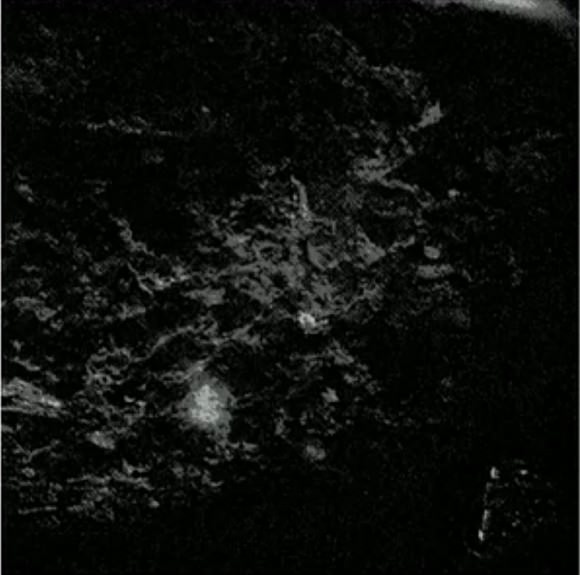
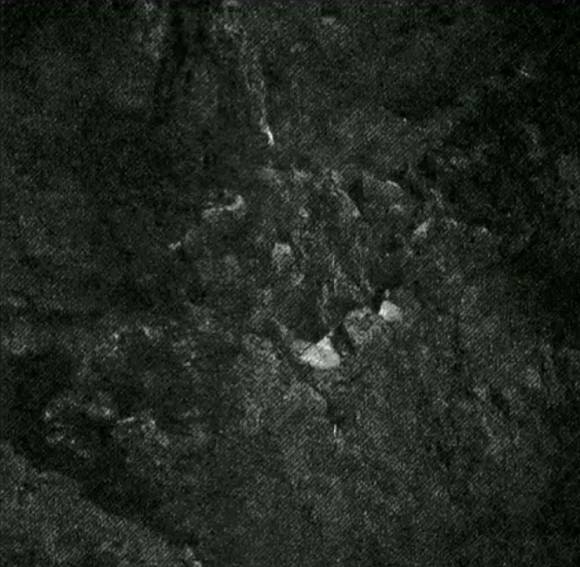
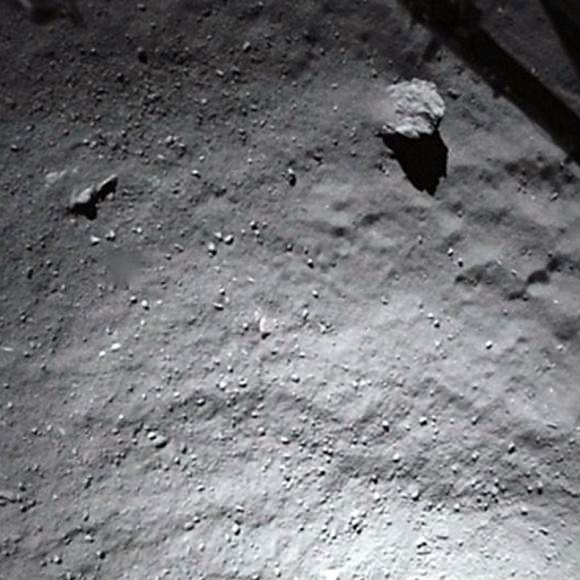

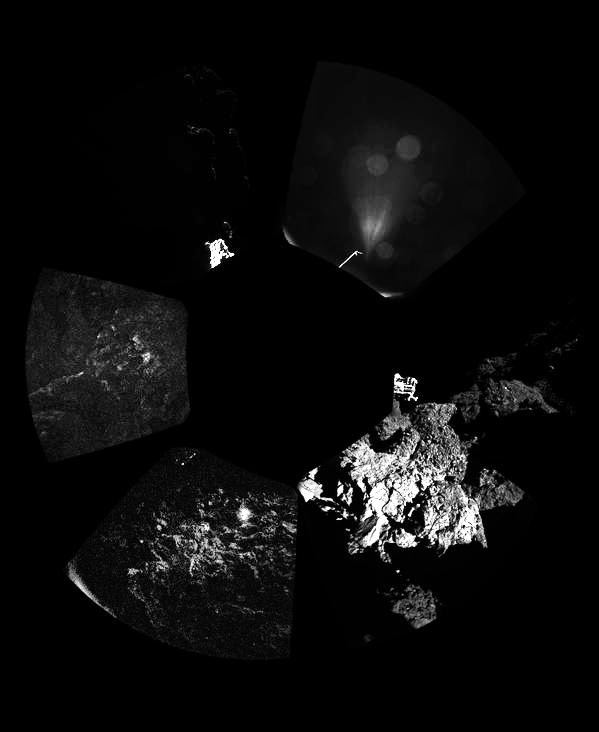
Great coverage Bob. I’m on this bicycle trip and ran into water, rain in California! There’s water in my gear, on the streets, the same water that all those comets delivered to Earth billions of years ago. Keeps getting cycled around, to our benefit.
One can imagine that engineers had time (10+ yrs) to consider a lot of landing scenarios, particularly in terms of power generation. The small amount of power produced from solar panels after the batteries are drained, indicates how little power is required to maintain Philae. By cutting back science operations , they could extend its lifetime on battery alone for several days. They must now be weighing the potential to do science on 1.5 hrs sunlight vs the risky option of using the MUPUS hammer arm to move Philae to a more fortuitous position.
“There’s water in my gear, on the streets, the same water that all those comets delivered to Earth billions of years ago.”
You’re forgetting virtually 70% of your own body content.
Just thought I would bring the point closer to home. Actually, closer than that. 🙂
Certainly within us. It’s the Earth s water cycles that make retention of that 70% possible, gravity and a magnetic field that allowed Earth to retain water delivered by comets, whether it was 5% or 90% of what we have now.
You mean the water delivered with the planetesimal accreation.
With isotope measurements of the last few years, the comet delivery could be at most 40 %.
The recent find that about half our water predates the protoplanetary disk shrinks the likelihood of comet delivered water to 20 %. [ http://www.space.com/27256-earth-water-older-than-sun.html ]
And more recently still (31/10!), the find of water in Vesta meteorites shows at best a few percent of delivered volatiles derive from comets, but were present at most 10-20 million years after the protoplanetary disk formed. [“Early accretion of water in the inner solar system from a carbonaceous chondrite-like source”, Saraflan et al, Science]
Having water being present at accretion is consistent with the early cold, wet Earth @ 4.4 billion years that zircons tells us of.
I hope Philae can support the spectroscopic (I think) D/H and 15N/14N ratios, and exclude comets as volatile source. That would up the frequency of habitable planets considerably, and given a much earlier habitability it would up the frequency of life on those habitables a lot too. A win-win result!
I made an ambient sleep sound using only the EM emissions of 67P to commemorate this event: https://www.youtube.com/watch?v=HA_J_3xyt8g&list=UUF6R1ZDskjCeBMomUGCtxXw
What’s a “sleep sound”? Apart from snoring, that is.
Tweet from Philae: I traveled 350 million miles to get stuck in a box canyon…beautiful.
Billions of dollars to find out the comet is actually a rock with lots of hard places and the lander is stuck in between. Sometimes I wonder, did we really need to know?
Well, I for instance want to know what a comet is made of billions time more than knowing your opinion on that.
You seem intelligent? try googling comet and think what we could have done with those billions of $
*Amount of money spent annually on perfumes in Europe and the United States: $12 billion.
*Amount of money spent annually on cosmetics in the United States: $8 billion.
*Amount of money spent each year on pet food in Europe and the United States: $17 billion.
*Amount of money spent each year on militaries worldwide: $780 billion.
😉
[*Sources: U.N. Development Programme (UNDP), Human Development Report 1998 (New York: Oxford University Press, 1998), pages 30 through 37.]
Ivan am not sure what your point is? everyone is wasting money so why not waste some more? If you think you are happy, try taking perfume away from women and they will make life miserable for you. same for cosmetics. what are pets supposed to eat. Pets provide emotuinal support for people. nomoney for military, well we will all become Russian and or Islamic or dead. you choose. clearly some things are necessary. Knowing that comets are made of ice is important to very few compared to the multitudes you have cited. I love scince by the way, but some things are better put off till times are better in my opinion